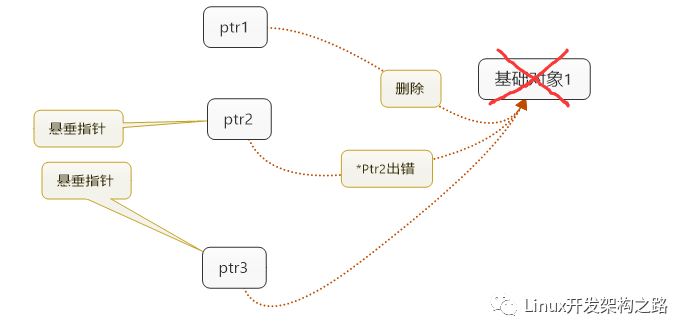一、智能指針的學習:
1、內存泄漏:
關于內存泄漏這個問題,一般都會牽扯到指針這個話題,也就是我們常說的動態內存分配;然而在程序員手動進行堆空間的分配時(指針無法控制所指堆空間的生命周期,),往往在寫完程序的時候,程序員一不小心就忘了釋放已經手動分配的內存大小,導致軟件Bug不斷(也就是內存泄漏)。
在C++語言里面又沒有垃圾回收的機制(不像高級語言Java有自動的垃圾回收機制,),所以程序員在寫程序的時候,經常會發生剛才上面說的那種情況,這里我們來看一個例子:
#include 《iostream》
#include 《string》
using namespace std;
class Test
{
int i;
public:
Test(int i)
{
this-》i = i;
}
int value()
{
return i;
}
~Test()
{
}
};
int main()
{
for(int i=0; i《5; i++)
{
Test* p = new Test(i);
cout 《《 p-》value() 《《 endl;
}
return 0;
}
輸出結果:
txp@ubuntu:~$ 。/a.out
0
1
2
3
4
注解:上面分配的堆空間,沒有釋放掉
2、我們需要什么?
需要一個特殊的指針: 智能指針對象,通過類的普通構造函數完成;
指針生命周期結束的時候,主動釋放堆空間
一片堆空間最多只能由一個指針標識:避免多次釋放內存,通過拷貝構造函數和賦值操作符完成;
杜絕指針運算和指針比較
3、智能指針的使用:
重載指針特征操作符(-》和*)
只能通過類的成員函數重載
重載函數不能使用參數
只能定義一個重載函數
代碼實踐:
#include 《iostream》
#include 《string》
using namespace std;
class Test
{
int i;
public:
Test(int i)
{
cout 《《 “Test(int i)” 《《 endl;
this-》i = i;
}
int value()
{
return i;
}
~Test()
{
cout 《《 “~Test()” 《《 endl;
}
};
class Pointer
{
Test* mp;
public:
Pointer(Test* p = NULL)// 1,智能指針對象,通過類的普通構造函數完成;
{
mp = p;
}
Pointer(const Pointer& obj)//避免多次釋放內存,通過拷貝構造函數和賦值操作符完成;
{
mp = obj.mp;// 傳遞堆空間的控制;
const_cast《Pointer&》(obj).mp = NULL;//初始化對象不管之前的;堆空間了,做所有權的轉移,保證堆空間最多只能由一個對象被標識;
}
Pointer& operator = (const Pointer& obj)
{
if( this != &obj )
{
delete mp;
mp = obj.mp;
const_cast《Pointer&》(obj).mp = NULL;
}
return *this;
}
Test* operator -》 () // 返回指針,準備指示;
{
return mp;
}
Test& operator * () // 解引用,返回對象;
{
return *mp;
}
bool isNull()
{
return (mp == NULL);
}
~Pointer()
{
delete mp;
}
};
int main()
{
Pointer p1 = new Test(0);
cout 《《 p1-》value() 《《 endl;
Pointer p2 = p1;
cout 《《 p1.isNull() 《《 endl;
cout 《《 p2-》value() 《《 endl;
return 0;
}
輸出結果:
txp@ubuntu:~$ 。/a.out
Test(int i)
0
1
0
~Test()
總結提示:智能指針是一個類,這個類的構造函數中傳入一個普通指針,析構函數中釋放傳入的指針。智能指針的類都是棧上的對象,所以當函數(或程序)結束時會自動被釋放
二、總結:
指針特征操作符(-》和*)可以被重載
重載指針特征符能夠使用對象代替指針
智能指針只能用指向堆空間中的內存
智能指針的意義在于最大程度的避免內存問題
-
C++
+關注
關注
22文章
2113瀏覽量
73742
原文標題:C++之智能指針的學習總結
文章出處:【微信號:gh_c472c2199c88,微信公眾號:嵌入式微處理器】歡迎添加關注!文章轉載請注明出處。
發布評論請先 登錄
相關推薦
初學者該如何學習C++
嵌入式學習方法步驟是什么?
學習C++的方法以及C++的就業方向
C++的引用和指針
rust語言基礎學習: 智能指針之Cow
C++智能指針的底層實現原理





 C++智能指針的學習方法介紹
C++智能指針的學習方法介紹













評論